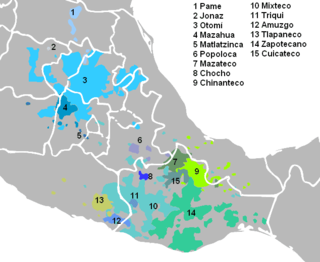Top Qs
Timeline
Chat
Perspective
Chinantecan languages
Oto-Manguean language branch of Mexico From Wikipedia, the free encyclopedia
Remove ads
The Chinantec or Chinantecan languages constitute a branch of the Oto-Manguean family. Though traditionally considered a single language, Ethnologue lists 14 partially mutually unintelligible varieties of Chinantec.[2] The languages are spoken by the indigenous Chinantec people who live in Oaxaca and Veracruz, Mexico, especially in the districts of Cuicatlán, Ixtlán de Juárez, Tuxtepec and Choapan, and in Staten Island, New York.[3]
Remove ads
Internal classification
Summarize
Perspective
Egland and Bartholomew (1978)[4] established fourteen Chinantec languages on the basis of 80% mutual intelligibility. Ethnologue found that one that had not been adequately compared (Tlaltepusco) was not distinct, but split another (Lalana from Tepinapa). At a looser criterion of 70% intelligibility, Lalana–Tepinapa, Quiotepec–Comaltepec, Palantla–Valle Nacional, and geographically distant Chiltepec–Tlacoatzintepec would be languages, reducing the count to ten. Lealao Chinantec (Latani) is the most divergent.
Remove ads
Phonology

Chinantecan languages have ballistic syllables, apparently a kind of phonation.[5][6][7]
All Chinantec languages are tonal. Some, such as Usila Chinantec and Ojitlán Chinantec, have five register tones (in addition to contour tones), with the extreme tones deriving historically from ballistic syllables.[8]
Grammar
Grammars are published for Sochiapam Chinantec,[9] and a grammar and a dictionary of Palantla (Tlatepuzco) Chinantec.[10][11]
Example phrase:
- ca¹-dsén¹=jni chi³ chieh³
- ‘I pulled out the hen (from the box).[11]
The parts of this sentence are: ca¹ a prefix which marks the past tense, dsén¹ which is the verb stem meaning "to pull out an animate object", the suffix -jni referring to the first person, the noun classifier chi³ and the noun chieh³ meaning chicken.
Whistled speech
The Chinantec people have practiced whistled speech since the pre-Columbian era. The rhythm and pitch of normal Chinantec speech allow speakers of the language to have entire conversations only by whistling. The sound of whistling carries better than shouting across the canyons of mountainous Oaxaca. It enables messages to be exchanged over a distance of up to one kilometre (0.62 mi). Whistled speech is typically only used by Chinantec men, although women also understand it. Use of the whistled language is declining, as modern technology such as walkie-talkies and loudspeakers have made long-distance communication easier.[12]
Remove ads
Media
Chinantec-language programming is carried by the CDI's radio stations XEOJN, broadcasting from San Lucas Ojitlán, Oaxaca, and XEGLO, broadcasting from Guelatao de Juárez, Oaxaca.
- Example of Chinantec in written form from the Biblioteca Cervantina
- Example of Chinantec in written form from the Biblioteca Cervantina
References
External links
Wikiwand - on
Seamless Wikipedia browsing. On steroids.
Remove ads



